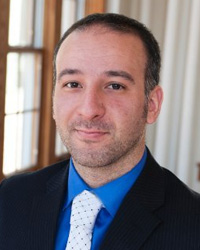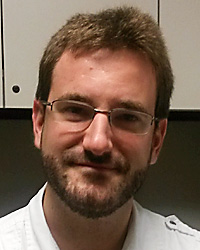Past CNS Talks

The Office of Public Health Scientific Services (OPHSS) at the Centers for Disease Control and Prevention (CDC)
Dr. Chesley Richards
Abstract: The Office of Public Health Scientific Services (OPHSS), within the Centers for Disease Control and Prevention (CDC), oversees two CDC national centers, the National Center for Health Statistics and the Center for Surveillance, Epidemiology and Laboratory Services. OPHSS also has CDC-wide functions, and is responsible for leading, promoting and facilitating science, standards and policies to reduce the burden of diseases in the U.S. and globally. One of OPHSS’ key duties is to ensure that public health surveillance activities are performing as needed. Over the past several years, state and local health departments and the U.S. Congress have called for enhancement’s to CDC’s public health surveillance systems. In response, the CDC Director has charged OPHSS with leading the CDC Surveillance Strategy to make these enhancements. The challenges, opportunities for improvement, and activities to date under the Surveillance Strategy will be presented. Concluding thoughts about future directions, including collaboration opportunities, will be offered and may serve as a basis further discussion.
Bio: Dr. Chesley Richards is the CDC Deputy Director for Public Health Scientific Services and Director of OPHSS

Early warning signals of critical transitions in mood
Ingrid Van de Leemput
Abstract: About 17% of humanity goes through an episode of major depression at some point in their lifetime. Despite the enormous societal costs of this incapacitating disorder, it is largely unknown how the likelihood of falling into a depressive episode can be assessed. One approach is to view the mood system as a dynamic network where emotions interact, such that reinforcing feedbacks between emotions could propagate a person into a disorder. As complex dynamical systems approach a tipping point, their dynamics tend to become dominated by a phenomenon known as critical slowing down. Using time series of autorecorded mood, we have shown that indicators of slowing down are also predictive of future transitions to and from depression. These results support the hypothesis that mood may have alternative stable states separated by tipping points, and suggest an approach for assessing the likelihood of transitions into and out of depression. However, these methods rely on self-assessment. Currently, we are investigating whether one could reliably monitor a person’s mood in individual Twitter timelines to find early warning signals of mood transitions such as depression.
Bio: Ingrid van de Leemput is a Visiting Research Scholar at the School of Informatics and Computing of IU. She recently finished her PhD at Wageningen University in the Netherlands on mathematical search images for insights into the stability and resilience of ecosystems, psychiatric disorders, and biogeochemical pathways. Her present research interest is the use of Twitter data in the identification of early warning signals of critical transitions in individuals and societies.

Measuring Scholarly Impact and Beyond
Ying Ding
Abstract: Measuring scholarly impact is becoming crucial for funding allocation, tenure-related promotion, and strategic planning. With the ever-increasing power of computing technology and vast amount of available enriched unstructured and structured data, measuring scholarly impact is moving from a simple counting of numbers, to utilizing topic and entity metrics for in-depth semantic measures of knowledge usage and diffusion, to finally enable knowledge discovery. This talk will showcase examples to demonstrate this paradigm shift, and presents exciting research outputs as well as prototype tools, ready for further development and deployment.
Bio: Dr. Ying Ding is an Associate Professor at School of Informatics and Computing, Indiana University. Previously she worked as a senior researcher at the University of Innsbruck, Austria and as a researcher at the Free University of Amsterdam, the Netherlands. She has been involved in various NIH, NSF and European-Union funded projects. She has published 170+ papers in journals, conferences and workshops. She is the co-editor of book series called Semantic Web Synthesis by Morgan & Claypool publisher. She is co-author of the book "Intelligent Information Integration in B2B Electronic Commerce" published by Kluwer Academic Publishers. She is also co-author of book chapters in the book "Spinning the Semantic Web" published by MIT Press and "Towards the Semantic Web: Ontology-driven Knowledge Management" published by Wiley. She is the editorial board member of four top journals in Information Science and Semantic Web. Her current research interest areas include social network analysis, Semantic Web, citation analysis, knowledge management and application of Web Technology.

Identifying the Drivers of Shopper Attention, Engagement, and Purchase
Raymond Burke
Abstract: To cope with the complexity of modern retail stores and personal time constraints, shoppers must be selective in processing information. During a typical shopping trip, they visit only a fraction of a store’s departments and categories, examine a small subset of the available products, and, in some cases, make selections in just a few seconds. New research techniques have been developed to help marketers understand how customers allocate their attention in a complex, competitive environment, and assess the impact of in-store factors on shopper behavior. This paper summarizes studies using video-based customer tracking tools, virtual reality simulations, and eye tracking to identify the drivers of shopper attention, product engagement, and purchase conversion. These include shopper goals; product assortment, package appearance, price, and merchandising; shelf space allocation, organization, and adjacencies; and salesperson interaction and crowding conditions. The research reveals that small changes in a product’s appearance and presentation can have a powerful impact on shopper engagement and purchase conversion, and explores the implications for new product testing.
Bio: Raymond R. Burke is the E.W. Kelley Professor of Business Administration at Indiana University's Kelley School of Business, and founding director of the School's Customer Interface Laboratory, a state-of-the-art facility for investigating how customers interact with new retail environments and technologies. He has also served on the faculties of the Harvard Business School and the University of Pennsylvania's Wharton School. Dr. Burke’s research focuses on understanding the influence of point-of-purchase factors – including new products, product packaging, pricing, promotions, assortments, and displays – on consumer shopping behavior. His articles have appeared in several major journals, including the Harvard Business Review, the Journal of Consumer Research, the Journal of Marketing, and Marketing Science.

Network Science—Learning from the Past
Stanley Wasserman
Abstract: J.L. Moreno stated in April 1933: "If we ever get to the point of charting a whole city or a whole nation, we would have … a picture of a vast solar system of intangible structures, powerfully influencing conduct, as gravitation does in space. Such an invisible structure underlies society and has its influence in determining the conduct of society as a whole."
Here, more than 80 years later, we are still trying to achieve this goal. In this talk, I review some of Moreno’s work (as well as the work of Davis, Leinhardt, and Holland) , and discuss how far we have (and have not come) in these past 80 years since the birth of Network Science.
Bio: As a leading methodologist in the field of network analysis, Stan Wasserman designs studies, creates models, and analyzes data for researchers around the world in such varied areas as management, community psychology, and public health. He is also the coordinating editor of "Network Science", a major new journal in the field published by Cambridge University Press. His book "Social Network Analysis: Methods and Applications" is a classic in the field, still in print after more than 20 years, and widely used in university courses. He was one of the first network scientists at IU, and through conference grants, collaborations, and teaching, he continues to be an important network research presence on campus.
Wasserman holds a joint appointment in the departments of Statistics and Psychological and Brain Sciences in the College of Arts and Sciences at IU. He also serves as the scientific supervisor for the Laboratory for Applied Network Research and Research Professor at the Higher School of Economics in Moscow — consulting, teaching, and collaborating with faculty and students at the school and ensuring the lab’s connectedness with the broader world of network science.
He has been doing network research for more than 40 years, and has watched the field grow almost exponentially.

Studying mood variations in longitudinal twitter timelines: applications to the detection of psychological transitions
Johan Bollen
Bio: Johan Bollen is an Associate Professor at the Indiana University School of Informatics and Computing. He was a Staff Scientist at the Los Alamos National Laboratory from 2005-2009, and an Assistant Professor at the Department of Computer Science of Old Dominion University from 2002 to 2005. He obtained his Ph.D. in Experimental Psychology from the University of Brussels in 2001 on the subject of cognitive models of human hypertext navigation. He has taught courses on Data Mining, Information Retrieval and Digital Libraries. His research has been funded by the Andrew W. Mellon Foundation, National Science Foundation, Library of Congress, National Aeronautics and Space Administration and the Los Alamos National Laboratory. His present research interests are usage data mining, complex networks, computational sociometrics, informetrics, and digital libraries. He has extensively published on these subjects as well as matters relating to adaptive information systems. He is presently the Principal Investigator of the MESUR project. See his personal home page here.

Topics over Time: Into Darwin’s Mind
Jaimie Murdock
Abstract: For 21 years, Charles Darwin kept meticulous notebooks of his reading history - both research and otherwise. The time span of these readings covers almost exactly the period of time between publication of The Voyage of the Beagle and The Origin of Species, making it a remarkably interesting dataset. Using the HathiTrust to gather fulltext records of the volumes in his notebooks, we are able to use Latent Dirichlet Allocation topic modeling to trace the intellectual development of Darwin’s Origin. I present two new measures of the interaction between time and semantics, along with a method for comparing a created work to a series of readings. This enables us to examine how his reading order impacted the publication time of the Origin, to show if Darwin was conducting a directed search to support his theory of evolution, and to create a null model of reading order within a topic model.
Bio: Jaimie Murdock is a PhD Student at Indiana University in Cognitive Science & Informatics and the lead developer of the Indiana Philosophy Ontology (InPhO) Project. His research on topic modeling and ontology evaluation in the humanities has been demonstrated at the AAAI, JCDL, and WWW conferences. http://jamram.net

Intellectual diversity of scientific disciplines and research teams
Staša Milojević
Abstract: Highly publicized results from large research teams suggest that ‘big science’ is more successful and innovative than the efforts of small teams and single authors. That raises the question of whether small science has value in today's scientific landscape, and whether society should invest in it. A possible downside of the move towards highly collaborative research is that it could affect the heterogeneity of research approaches and the topics studied. In order to establish if that is the case, one needs a method that can measure the intellectual diversity of different types of research teams through time independent from sheer productivity. In this talk I will propose an innovative method to measure the size of the intellectual domain of scientific disciplines based on an automated extraction of concepts contained in the titles of scientific publications. The method is applied to 20 million articles in three disciplines over the periods of 120 years and yields some intriguing results that suggest that small teams including individual authors are still instrumental for continued growth of science.
Bio: Staša Milojević is an Assistant Professor in the School of Informatics and Computing at Indiana University. Her research focuses on studying how modern scientific disciplines form, organize and develop. She approaches modern scientific fields as complex heterogeneous socio-cultural networks of people, ideas, documents and institutions. In large-scale longitudinal studies of fields such as nanoscience she combines models, theories and methods from information science, science and technology studies, and social network analysis.

Abstract: Science is fundamentally a process of proposing models, gathering data, analyzing the data, and disseminating results. Much of that activity is now done online. But while the basic activities are the same, different areas of science have different formats for storing data, use different programming languages to build analysis tools, and have different workflows and modes of collaboration.
Enter HUBzero, an open source software platform used to create Web sites for research, education, and scientific collaboration. Some call them “science gateways,” or “collaboratories.” We call them “hubs” for the community. HUBzero started with the NSF-sponsored Network for Computational Nanotechnology and the development of their Web site at nanoHUB.org. Since 2009, HUBzero has been used to create more than 60 such hubs across a wide range of scientific disciplines beyond nanotechnology, including earthquake mitigation, bio-fuels, environmental modeling, volcanic activity, cancer research, pharmaceutical engineering, and STEM education, to name a few. All together, these sites have served more than 1,800,000 visitors from 172 countries worldwide during the past year alone.
As scientists collaborate within each hub, the web server records their activity. This gives us an unprecedented capability to track activities and measure impact. HUBzero automatically tracks and reports metrics about the use of simulation tools and other published materials, about the aggregate impact of each contributor, about the activity within collaborative projects, and about access to each site as a whole. More information is recorded than is analyzed and made available, so there remains a huge opportunity to study various hubs as a crucible for social science, with an eye toward understanding and improving the discovery process.
Bio: Michael McLennan is a Senior Research Scientist at Purdue University and Director of the HUBzero Platform for Scientific Collaboration. He created the Rappture toolkit as part of that platform. He has more than 25 years of software development experience in both academic and corporate environments, with an emphasis on computer-aided design tools and user interface design.
Dr. McLennan received a Ph.D. in 1990 from Purdue University for his dissertation on dissipative quantum mechanical electron transport in semiconductor heterostructure devices. He became a Tcl enthusiast when he joined Bell Labs in 1992 to work on tools for semiconductor device and process simulation. He is co-author of “Effective Tcl/Tk Programming” (published by Addison-Wesley) and “Tcl/Tk Tools” (published by O’Reilly and Associates). He also developed [incr Tcl], an object-oriented extension of Tcl, which has been used by thousands of developers worldwide, on projects ranging from the TiVo digital video recorder to the Mars Pathfinder.

Leveraging Social Networks to Understand Behavioral and Biological Pathways in Substance Abuse and Dependence
Brea Perry
Abstract: Social networks influence and moderate critical biological and behavioral pathways in substance misuse, abuse, and dependence. Social network concepts and methodologies – such as two-mode or affiliation networks – can be used to understand drug and alcohol behavior on multiple scales, from molecular processes inside the body to structural anomalies in patterns of ties between millions of actors. An example of the utility and versatility of SNA is provided using the case of doctor shopping (i.e. visiting multiple prescribers) for illicit prescription drugs. This emerging approach seeks to identify and analyze patterns of doctor shopping for opioids and benzodiazepines using two-mode social network analysis of very large, national health insurance claims databases. Results from these analyses can provide important insights to inform effective policies and interventions at the point of service (i.e. prescribers) to reduce prescription drug abuse, diversion, and overdose mortality. Applying two-mode SNA – a complex, systems science methodology – to drug abuse research has the potential to facilitate rapid information extraction from extant datasets for translation to policy and practice, including evaluation of evolving state and federal prescription drug policies and prescription drug monitoring programs. This case demonstrates how SNA might be leveraged to improve population health by increasing our ability to identify complex and often hidden substance abuse pathways and opportunity structures.
Bio: Brea Perry is an Associate Professor of Sociology at Indiana University, and received a Ph.D. in Sociology from IU in 2008. Prior to returning to Indiana in 2014, she was an Associate Professor at the University of Kentucky, where she founded and directed the interdisciplinary Health, Society, and Populations Program. Her research and teaching interests include social networks, medical sociology, mental illness, biosociology, social genetics, and quantitative methodology. One line of research focuses on complex interactions between genotypes, social statuses, and social environmental conditions (GxExE) in substance use pathways. Dr. Perry also studies personal social network dynamics and processes that accompany progression through illness careers. Much of her work employs egocentric social network analysis and multilevel and longitudinal modeling.
Dr. Perry’s research has been funded by the National Institutes of Health, the National Science Foundation, the Spencer Foundation, and the McManus Foundation. She has published over 35 articles and book chapters since 2006, and her work appears in top journals across disciplines, including sociology, psychology, medicine, and genetics. She is currently the series editor of Advances in Medical Sociology, and her edited volume entitled Health, Society, and Genetics will be released in the summer of 2015.

Discovering connections among 4 billion health data points, starting with two
Titus Schleyer, DMD, PhD, with Siu Hui, PhD
Abstract: Indiana sits atop one of the most comprehensive and sophisticated collections of healthcare data in the world: the Indiana Network for Patient Care (INPC). Having been developed since 1972, the INPC is an operational, community-wide electronic medical record that supports patient care for 13 million patients in Indiana and neighboring states. For these patients, it hosts detailed healthcare data, including 28m registration “events,” 1.7b clinical observations, 840m encounter events, 580m claims observations (procedures, prescriptions, etc.) and 118m text reports. For many participating institutions, the INPC stores a wide range of clinical information, such as demographics, visit dates, chief complaints, problem lists and diagnoses, laboratory results, physician notes, orders, medications, vital signs, and admissions and discharge summaries/instructions. Today, a volume of 2m transactions, coming from 25,000 clinicians, 106 hospitals, county and state public health departments, national laboratories, pharmacies is added to the INPC daily.
The question is how can we most effectively learn from his large body of real-world healthcare data? The Regenstrief Institute and its collaborators have, over several decades, conducted retrospective studies using the INPC in order to elucidate various clinical conditions, and their treatments and outcomes. For example, we have found that steroid inhalers lead to more gastrointestinal problems that can be mitigated by using a spacer; physicians who perform more endoscopic retrograde cholangiopancreatography, a technically difficult procedure performed on the pancreas, have better patient outcomes; a substantial proportion of patients with osteoporosis remain at high risk of fractures despite adherence to medicines; taking certain combinations of medicines may increase the risk of myopathy (a muscle disorder). However, we estimate that we have only exploited a small fraction of the potential lessons that INPC data could teach us.
In order to increase our “analytical bandwidth,” we are looking to leverage novel analytical and visualization methodologies. Despite applications in biological, genomic and proteomic domains, network analysis has not been widely used in the analysis of clinical data. The main purpose of this talk is to stimulate a discussion about the potential for applying network analysis and advanced visualization to healthcare data through a collaboration between the newly formed IU Network Science Institute and the Regenstrief Institute Center for Biomedical Informatics.
Bio: Titus Schleyer, DMD, PhD, is the Clem McDonald Professor of Biomedical Informatics and Director of the Center for Biomedical Informatics at the Regenstrief Institute (http://www.regenstrief.org), as well as Professor of Medicine, Department of Medicine, Indiana University School of Medicine. He holds DMD degrees from the University of Frankfurt, Germany, and Temple University, Philadelphia, as well as a PhD degree in molecular biology from the University of Frankfurt and an MBA degree in Health Administration from Temple University. Dr. Schleyer has been active in biomedical informatics research since 1989, conducting seminal research on electronic dental records and Internet applications, and workflow and human-computer interaction in dentistry. Dr. Schleyer was a co-director of the Biomedical Informatics Training Program of the School of Medicine, University of Pittsburgh. He founded the Department of Dental Informatics at Temple University, as well as the Center for Dental Informatics at the University of Pittsburgh. Dr. Schleyer's informatics research is primarily funded by the National Institutes of Health. In 2009, Dr. Schleyer was elected to the American College of Medical Informatics.
Dr. Hui, the senior biostatistician at the Institute, collaborates with other Institute scientists and conducts her own research. Her major projects involve issues with aging, including osteoporosis, menopause, dementia and cardiovascular disease. Her research interest is in the development of statistical methods and the application of innovative techniques to address biomedical and health services research questions. Statistical areas include missing and longitudinal data, statistical modeling, and measurement errors.

Modeling Meaning at Multiple Scales
Colin Allen
Abstract: I will describe an approach developed by my InPhO group as part of our recent “Digging by Debating” project, conducted in collaboration with Katy Börner’s research group and two research groups in the UK, to apply LDA topic models at multiple scales to locate and identify key arguments at the interface of science and philosophy. The interpretability of topic models is a key challenge and the art of doing so has been compared in the literature to reading tea leaves. I will discuss this problem in the context of our attempts to quantify and visualize meaningful relationships among the topics and documents.
Bio: Colin Allen is Provost Professor of Cognitive Science and of
History & Philosophy of Science in the College of Arts and
Sciences at Indiana University, Bloomington, where he has been a
faculty member since 2004.
He is a member of IU's Center for the Integrative Study of Animal
Behavior and the Program in Neuroscience, and he also holds an
adjunct appointment in the Department of Philosophy.
He is currently serving as director of IU's Cognitive Science program,
since July 2011.
Allen currently also holds adjunct positions at Arizona State
University and Xi'an Jiaotong University, Xi'an, China.
Allen's main area of research is on the philosophical foundations of
cognitive science, particularly with respect to nonhuman animals. He
is interested in the scientific debates between ethology and
comparative psychology, and current issues arising in cognitive ethology.
Allen has also published on other topics in the philosophy of mind and
philosophy of biology, and artificial intelligence.
His most recent book is Moral Machines: Teaching Robots Right from
Wrong (Oxford University Press 2009), coauthored with Wendell
Wallach.
Allen's full CV is available at http://mypage.iu.edu/~colallen/cv.html [photo]

The rise of social bots: fighting deception and misinformation on social media
Emilio Ferrara
Abstract: One of the classic problems in Computer Science, recognizing the behavior of a human from that of a computer algorithm (proposed by Alan Turing), has suddenly become very relevant in the context of social media. Limits to the expressive power of humans and real incentives abound to develop human-mimicking software agents called social bots. These elusive entities wildly populate social media ecosystems, often going unnoticed among the population of real people. Bots can be harmful, aiming at persuading, smearing, or deceiving, and for such a reason our research aims at developing efficient systems to detect them.
In my talk I will discuss the characteristics of modern, sophisticated social bots, and how their presence can endanger online ecosystems and our society. Characteristics related to content, network, sentiment, and temporal patterns of activity are imitated by bots but at the same time can help discriminate synthetic behaviors from human ones, yielding signatures of engineered social tampering. I will present "Bot or Not?", a social bot detection framework prototype developed at Indiana University under the Truthy project. My talk will conclude depicting future scenarios and discussing related problems, such as that of studying persuasion campaigns on social media, how they spread, and how we can promptly detect and potentially hinder their diffusion.
Bio: Dr. Emilio Ferrara is a Research Scientist at the IU Network Science Institute and Research Professor at the School of Informatics and Computing of IU, where he teaches I400/590 Mining the Social Web. He holds a Ph.D. in Mathematics and Computer Science (U. of Messina, 3/12). He was a visiting scholar at the Vienna University of Technology, an intern at Lixto GmbH (2010), and a visiting researcher at Royal Holloway University of London (2011/12). He was a Postdoctoral Fellow of the Center for Complex Networks and Systems Research at Indiana University, working with A. Flammini and F. Menczer (2012/14).
Ferrara’s research interests include Computer Science, Network Science, Data Science, Machine Learning, and Computational Social Science, with applications in Social Networks and Media Analysis, Criminal Networks, and Knowledge Engineering. His research appears on top journals including Communications of the ACM, Physical Review Letters, Information Sciences, EPJ Data Science, PLoS One, Knowledge-based Systems, Expert Systems with Applications, and various ACM and IEEE Transactions and Conferences.
He is Lead Editor of the EPJ Data Science thematic series on "Collective Behaviors and Networks” and serves as reviewer for prestigious journals including various ACM and IEEE Transactions, Information Sciences, JASIST, Nature Scientific Reports, and PLoS One; for conferences such as WWW, ICWSM, and SocInfo; and on grant panels for the Chilean Government, the Swiss Confederation, and the Austrian FWF. Ferrara is Co-chair of various workshops recurring at ECCS, WWW, SocInfo, and WebScience; he was Local & Sponsor Chair of ACM Web Science 2014 and Publicity Co-chair of SocInfo 2014.
His work has been featured on the popular press including MIT Technology Review, New Scientist, Fast Company, Engadget, the Washington Post, the Seattle Times, the Atlantic, and Mashable!
He is a top 0.5% Kaggle competitor and participated in various data science competitions.

Mapping white matter neurodegeneration in the human connectome: a network science study of hereditary diffuse leukoencephalopathy with spheroids
Joaquín Goñi
Abstract: The effect of white matter neurodegeneration on the human connectome is an important topic with implications for the clinical applicability of advanced brain network analysis. Therefore, the aim of this study was to evaluate integration and segregation changes in structural connectivity (SC) that arise as consequence of white matter lesions in hereditary diffuse leukoencephalopathy with spheroids (HDLS).
HDLS is a rare autosomal dominant neurodegenerative disorder caused by mutations in the CSF1R gene. HDLS is characterized by severe white matter damage leading to prominent subcortical lesions detectable by structural MRI. Spheroids, an important feature of HDLS, are axonal swellings indicating damage. HDLS causes progressive motor and cognitive decline. The clinical symptoms of HDLS are often mistaken for other diseases such as Alzheimer’s disease, frontotemporal dementia, atypical Parkinsonism or multiple sclerosis. Our study is focused on the follow-up of two siblings, one being a healthy control (HC) and the other one being an HDLS patient.
In this report, deterministic fiber-tractography of diffusion MRI with multi-tensor modeling was used in order to obtain reliable and reproducible SC matrices. Integration changes were measured by means of SC shortest-paths (including distance and number of edges), whereas segregation and community organization were measured by means of a multiplex modularity analysis on the SC matrices.
Major integration disruption involved superior frontal (L,R), caudal middle frontal (R), precentral (L,R), inferior parietal (R), insula (R) and paracentral (L) regions. Major segregation changes were characterized by the disruption of a large bilateral module that was observed in the HC that includes the frontal pole (L,R), medial orbitofrontal (L,R), rostral middle frontal (L), superior frontal (L,R), precentral (L,R), paracentral (L,R), rostral anterior cingulate (L,R), caudal anterior cingulate (L,R), posterior cingulate (L,R), postcentral (L), precuneus (L,R), lateral orbitofrontal (R) and parsorbitalis (R).
The combination of tractography and network analysis permitted the detection and characterization of profound cortical to cortical changes in integration and segregation associated with HDLS white matter lesions. Our preliminary findings suggest that advanced network analytic approaches show promising sensitivity to known white matter pathology and progression. Further research is needed to address the specificity of network profiles for differentiation among white matter pathologies and diseases.
Bio: Joaquín Goñi is an Associate Research Scientist at the Indiana University Network Science Institute and Adjunct Assistant Research Professor in the Indiana University School of Medicine Department of Imaging and Radiological Sciences.
| 9:30 AM | Woodburn Hall 200

"Speed Dating"
For faculty interested in network science
Abstract: Wondering if network science can enhance your research?
Hoping to meet others who are interested in network science?
Interested in learning more about network science?
The inherently collaborative and interdisciplinary field of network science strives to understand the complexities and relationships that drive our social, psychological, scientific, and technological worlds. Its discoveries, novel methods of analysis, and tools for processing data are applicable to research in many fields, including medicine, computer science, the natural and social sciences, and the arts and humanities.
OVPR's Proposal Development Services invites you to a speed-networking event designed to foster new research collaborations among IU faculty who use–or hope to use–network science in their research. Based partly on the strategies of speed dating, participants will share their research interests in an accelerated fashion with other researchers who have similar interests. The event will take place on Friday, January 23, from 9:30a-noon.
There will be time at the end of the event for participants to continue conversations and make additional connections.
Participants who develop an idea with a new collaborator will be eligible for seed funding of up to $2000.
Register (see link above) by December 17. Shortly after you register, you will receive a research interest questionnaire so you can be matched with complementary colleagues. Registration and completion of the questionnaire by January 5, 2015 are required for attendance.





